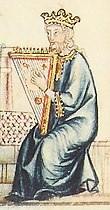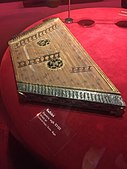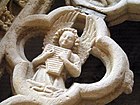music.wikisort.org - Instrument
A psaltery (Greek: ψαλτήρι) (or sawtry, an archaic form) is a fretboard-less board zither (a simple chordophone) and is considered the archetype of the zither and dulcimer; the harp, virginal, harpsichord and clavichord were also inspired by it. Its resonance box is usually trapezoidal, rectangular or in the form of a "pig's head" and often richly decorated.
This article needs additional citations for verification. (August 2022) |
Etymology
The psaltery of Ancient Greece (epigonion) was a harp-like stringed instrument. The word psaltery derives from the Ancient Greek ψαλτήριον (psaltḗrion), "stringed instrument, psaltery, harp"[3] and that from the verb ψάλλω (psállō), "to touch sharply, to pluck, pull, twitch" and in the case of the strings of musical instruments, "to play a stringed instrument with the fingers, and not with the plectrum."[4] The psaltery was originally made from wood, and relied on natural acoustics for sound production.
In the King James Bible "psaltery", and its plural, "psalteries", are used to translate several words from the Hebrew Bible whose meaning is now unknown.[5]
Characteristics
While the Greek instruments were harps, psaltery came to mean instruments that were strung across a resonating wood box.[2] The box-zither psalteries may have a Phoenician origin.[2] The strings of the medieval instrument were usually made of metal, unlike the finger-plucked harp, strung with catgut, and played using a plectrum or “pick.” The harp is strung with a single string for each tone, open to be plucked from either side of the instrument; a psaltery may have multiple strings for each tone, strung across a soundboard. The psaltery has been compared to the harpsichord[6] and dulcimer, though some forms of the latter are not plucked, but struck with hammers.[7]
Medieval and Renaissance psalteries
From the 12th through the 15th centuries, psalteries are widely seen in manuscripts, paintings and sculpture throughout Europe.[8][1] Examples found in one reference book, the Groves New Encyclopedia of Musical Instruments, show examples in paintings from the 9th century Carolingian Empire Benedictine Psalter, in 13th century Spain (in the Cantigas de Santa Maria), in Bohemia in the 14th century, in Italy in the 14th century, and Germany in the 15th century.[1]
Shapes included "triangular, trapezoidal, semitrapezoidal, wing shaped, or harp shaped".[2] The psalterion decacordum was shaped like a square and had ten strings strung vertically.[2] Stings could run in courses, as viewed in the middle-ages artwork.
Modern psaltery
While psalteries had largely died out in Europe by the 19th century, the salterio remained common in Mexico well into the twentieth century and is still played in some regional styles.
The hammered dulcimer and related instruments such as the santur, cimbalom, yangqin, and khim, appear very similar to psalteries and it is often hard to tell which one historical images represent. They differ in that the player strikes the strings with small hammers rather than plucking them. As a result, they have much higher string tension and heavier frames.
In the 19th century, several related zithers came into use, notably the guitar zither and the autoharp. In the 20th century, the bowed psaltery came into wide use. It is set up in a triangular format so that the end portion of each string can be bowed.
Gallery
- Psaltery in the shape called a "pig's head" psaltery, a very common psaltery shape in manuscripts.[1]
 Gorleston-on-Sea, England. Psaltery player from the Gorleston Psalter, c. 1310–1326.
Gorleston-on-Sea, England. Psaltery player from the Gorleston Psalter, c. 1310–1326.- (Kingdom of Bohemia, 14th century). Picture of an unusual type of psaltery, found in Central Europe. Labeled "Bohemian wing" psaltery in Grove Dictionary of Musical Intruments.[1]
- 18th century Spanish psaltery. Trapezoidal psaltery.
- Carolingian Empire. Page from the Benedictine Psalter (842-850). David playing a four-sided psaltery, psalterium quadratum or psalterium decochordum.[1]
- Spain. Three shapes of psalteries (bottom row) from the Cantigas de Santa Maria, Códice Rico.
- Germany, 15th century. Angel playing a pig's head psaltery.
- France
- France. 1145-1155. Elder of the Apocalypse
- France, Notre Dame Cathedral
- Spain. Burgos Cathedral.
- Spain, 13th century. Cancioneiro da Ajuda, folio 59, musicians with psaltery and clappers
- Triangular psaltery, Palatine Chapel, c. 1140 A.D.
See also
- Baltic psaltery
- Magadis
- Nevel (instrument)
- Psalterium (instrument)
- Qanun (instrument)
Notes
- Sadie, Stanley, ed. (1984). "Psaltery Frame zither". The New Grove Dictionary of Musical Instruments. pp. 39, 151–154. Volume 3.
- Marcuse, Sibyl (1975). A Survey of Musical Instruments. New York: Harper & Row. ISBN 0-06-012776-7.
- ψαλτήριον, Henry George Liddell, Robert Scott, A Greek-English Lexicon, on Perseus
- ψάλλω, Henry George Liddell, Robert Scott, A Greek-English Lexicon, on Perseus
- These words are the Hebrew keli (כלי) in Psalm 71:22 and I Chronicles 16:5; nevel (נבל) in I Samuel 10:5; 2 Samuel 6:5; I Kings 10:12; I Chronicles 13:8; 15:16, 20, 28; 25:1, 6; II Chronicles 5:12; 9:11; 20:28; 29:25; Nehemiah 12:27; Psalms 33:2; 57:6; 81:2; 92:3; 108:2; 144:9; and 150:3; and the Aramaic pesanterin (פסנתרין) in Daniel 3:5, 7, 10, and 15.
- Bucur, Voichita (29 August 2016). Handbook of Materials for String Musical Instruments. Springer. p. 51. ISBN 978-3319320809. Retrieved 10 August 2019.
- Jackson, Ronald (2013). Performance Practice: A Dictionary-Guide for Musicians. Routledge. p. 322. ISBN 978-1136767692. Retrieved 10 August 2019.
- Anon. (15th century). "Roi David jouant du psaltérion". (Chambéry, Savoie, France: manuscrit 4, fol. 319 v., Bréviaire franciscain, initiale B, psaume 1, Beatus vir) Musiconis.huma-num.fr (archive from 17 November 2018, accessed 15 June 2020).
References
- Chisholm, Hugh, ed. (1911). . Encyclopædia Britannica (11th ed.). Cambridge University Press.
External links
- Psaltery
- Discussion of psalteries, with image from the exhibition Making Musical Instruments: The making of musical instruments in Canada by the Canadian Museum of Civilisation
На других языках
- [en] Psaltery
[ru] Псалтерий
Псалте́рий, псалти́рь (греч. ψαλτήριον, от греч. ψάλλω — «щипать струны»[1]; лат. psalterium) — общее название древних многострунных щипковых музыкальных инструментов. По названию этого инструмента названа (в христианской традиции) ветхозаветная книга Псалтирь.Другой контент может иметь иную лицензию. Перед использованием материалов сайта WikiSort.org внимательно изучите правила лицензирования конкретных элементов наполнения сайта.
WikiSort.org - проект по пересортировке и дополнению контента Википедии




![Psaltery in the shape called a pig's head psaltery, a very common psaltery shape in manuscripts.[1]](http://upload.wikimedia.org/wikipedia/commons/thumb/0/0e/Walraversijde94.jpg/140px-Walraversijde94.jpg)

![(Kingdom of Bohemia, 14th century). Picture of an unusual type of psaltery, found in Central Europe. Labeled Bohemian wing psaltery in Grove Dictionary of Musical Intruments.[1]](http://upload.wikimedia.org/wikipedia/commons/thumb/e/ea/AlaBohemicaPsaltery.jpg/109px-AlaBohemicaPsaltery.jpg)

![Carolingian Empire. Page from the Benedictine Psalter (842-850). David playing a four-sided psaltery, psalterium quadratum or psalterium decochordum.[1]](http://upload.wikimedia.org/wikipedia/commons/thumb/d/d6/Benedictine_Psalter_-_King_playing_a_psalter.jpg/125px-Benedictine_Psalter_-_King_playing_a_psalter.jpg)







